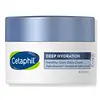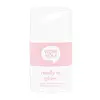What's inside
What's inside
 Key Ingredients
Key Ingredients

 Benefits
Benefits

 Concerns
Concerns

 Ingredients Side-by-side
Ingredients Side-by-side

Water
Skin ConditioningDicaprylyl Carbonate
EmollientGlycerin
HumectantCaprylic/Capric Triglyceride
MaskingGlyceryl Stearate Citrate
EmollientCetearyl Alcohol
EmollientNiacinamide
SmoothingAnhydroxylitol
HumectantButyrospermum Parkii Oil
EmollientCitric Acid
BufferingGlobularia Alypum Leaf Extract
Skin ConditioningHydrolyzed Hyaluronic Acid
HumectantPanthenol
Skin ConditioningPantolactone
HumectantPhenoxyethanol
PreservativeSodium Benzoate
MaskingSodium Polyacrylate
AbsorbentSqualane
EmollientTocopherol
AntioxidantXylitol
HumectantXylitylglucoside
HumectantWater, Dicaprylyl Carbonate, Glycerin, Caprylic/Capric Triglyceride, Glyceryl Stearate Citrate, Cetearyl Alcohol, Niacinamide, Anhydroxylitol, Butyrospermum Parkii Oil, Citric Acid, Globularia Alypum Leaf Extract, Hydrolyzed Hyaluronic Acid, Panthenol, Pantolactone, Phenoxyethanol, Sodium Benzoate, Sodium Polyacrylate, Squalane, Tocopherol, Xylitol, Xylitylglucoside
Water
Skin ConditioningPrunus Armeniaca Kernel Oil
MaskingEmulsifying Wax Nf
Glycerin
HumectantHelianthus Annuus Seed Oil
EmollientOlea Europaea Fruit Oil
MaskingCocos Nucifera Oil
MaskingButyrospermum Parkii Butter
Skin ConditioningStearic Acid
CleansingZinc Oxide
Cosmetic ColorantAllantoin
Skin ConditioningAvena Sativa Meal Extract
SoothingTocopherol
AntioxidantSodium Hyaluronate
HumectantXanthan Gum
EmulsifyingOryza Sativa Bran Oil
EmollientHydrolyzed Centella Asiatica Extract
AntioxidantPyrus Malus Fruit Extract
Skin ConditioningSodium Ascorbyl Phosphate
AntioxidantVitis Vinifera Seed Extract
AntimicrobialHibiscus Sabdariffa Callus Extract
AntioxidantPhenoxyethanol
PreservativeEthylhexylglycerin
Skin ConditioningCitrus Medica Peel Oil
Jasminum Officinale Oil
MaskingOrchis Mascula Extract
Skin ConditioningTetramethyl Acetyloctahydronaphthalenes
MaskingSantalum Album Oil
MaskingBenzyl Benzoate
AntimicrobialBenzyl Cinnamate
PerfumingBenzyl Salicylate
PerfumingLinalool
PerfumingLimonene
PerfumingWater, Prunus Armeniaca Kernel Oil, Emulsifying Wax Nf, Glycerin, Helianthus Annuus Seed Oil, Olea Europaea Fruit Oil, Cocos Nucifera Oil, Butyrospermum Parkii Butter, Stearic Acid, Zinc Oxide, Allantoin, Avena Sativa Meal Extract, Tocopherol, Sodium Hyaluronate, Xanthan Gum, Oryza Sativa Bran Oil, Hydrolyzed Centella Asiatica Extract, Pyrus Malus Fruit Extract, Sodium Ascorbyl Phosphate, Vitis Vinifera Seed Extract, Hibiscus Sabdariffa Callus Extract, Phenoxyethanol, Ethylhexylglycerin, Citrus Medica Peel Oil, Jasminum Officinale Oil, Orchis Mascula Extract, Tetramethyl Acetyloctahydronaphthalenes, Santalum Album Oil, Benzyl Benzoate, Benzyl Cinnamate, Benzyl Salicylate, Linalool, Limonene
 Reviews
Reviews

Ingredients Explained
These ingredients are found in both products.
Ingredients higher up in an ingredient list are typically present in a larger amount.
Glycerin is already naturally found in your skin. It helps moisturize and protect your skin.
A study from 2016 found glycerin to be more effective as a humectant than AHAs and hyaluronic acid.
As a humectant, it helps the skin stay hydrated by pulling moisture to your skin. The low molecular weight of glycerin allows it to pull moisture into the deeper layers of your skin.
Hydrated skin improves your skin barrier; Your skin barrier helps protect against irritants and bacteria.
Glycerin has also been found to have antimicrobial and antiviral properties. Due to these properties, glycerin is often used in wound and burn treatments.
In cosmetics, glycerin is usually derived from plants such as soybean or palm. However, it can also be sourced from animals, such as tallow or animal fat.
This ingredient is organic, colorless, odorless, and non-toxic.
Glycerin is the name for this ingredient in American English. British English uses Glycerol/Glycerine.
Learn more about GlycerinPhenoxyethanol is a preservative that has germicide, antimicrobial, and aromatic properties. Studies show that phenoxyethanol can prevent microbial growth. By itself, it has a scent that is similar to that of a rose.
It's often used in formulations along with Caprylyl Glycol to preserve the shelf life of products.
Tocopherol (also known as Vitamin E) is a common antioxidant used to help protect the skin from free-radicals and strengthen the skin barrier. It's also fat soluble - this means our skin is great at absorbing it.
Vitamin E also helps keep your natural skin lipids healthy. Your lipid skin barrier naturally consists of lipids, ceramides, and fatty acids. Vitamin E offers extra protection for your skin’s lipid barrier, keeping your skin healthy and nourished.
Another benefit is a bit of UV protection. Vitamin E helps reduce the damage caused by UVB rays. (It should not replace your sunscreen). Combining it with Vitamin C can decrease sunburned cells and hyperpigmentation after UV exposure.
You might have noticed Vitamin E + C often paired together. This is because it is great at stabilizing Vitamin C. Using the two together helps increase the effectiveness of both ingredients.
There are often claims that Vitamin E can reduce/prevent scarring, but these claims haven't been confirmed by scientific research.
Learn more about TocopherolWater. It's the most common cosmetic ingredient of all. You'll usually see it at the top of ingredient lists, meaning that it makes up the largest part of the product.
So why is it so popular? Water most often acts as a solvent - this means that it helps dissolve other ingredients into the formulation.
You'll also recognize water as that liquid we all need to stay alive. If you see this, drink a glass of water. Stay hydrated!
Learn more about Water